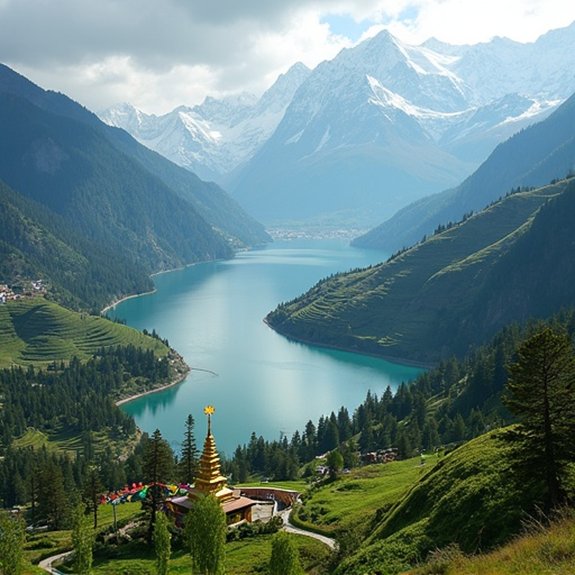The Mythical City of Shangri-La
The mythical city of Shangri-La‘s captured imaginations since James Hilton penned “Lost Horizon” in 1933. This hidden Himalayan paradise, where aging slows and wisdom flourishes, isn’t just fiction—it’s sparked real expeditions and government claims. Tibet’s monasteries, Bhutan’s valleys, and China’s renamed counties all stake their claim to Hilton’s vision. But what drives explorers to chase a novelist’s dream, and why do some insist they’ve found it?
Introduction

Paradise, utopia, heaven on earth—Shangri-La represents humanity’s eternal quest for a perfect sanctuary hidden from the world’s chaos. This mythical Himalayan valley first appeared in James Hilton’s 1933 novel “Lost Horizon,” capturing readers’ imaginations with its promise of eternal youth, wisdom, and peace. Hilton’s creation wasn’t pure fantasy; he drew inspiration from Tibetan Buddhist concepts of sacred hidden valleys called beyul and accounts from explorers who’d ventured into remote Asian mountains.
The name itself combines “Shangri” from Tibetan dialect with the suffix “La,” meaning mountain pass. Since its literary birth, Shangri-La‘s become synonymous with any earthly paradise—a place where time slows, conflict doesn’t exist, and inhabitants live for centuries in harmonious isolation from modern civilization’s corruption.
Lost Horizon Novel’s Impact
When James Hilton published “Lost Horizon” in 1933, he couldn’t have predicted how deeply his fictional valley would embed itself in global consciousness. The novel introduced Shangri-La as a mystical Himalayan paradise where aging slowed and Eastern wisdom flourished. Its protagonist discovers this hidden utopia after a plane crash, finding monks who’ve preserved humanity’s greatest knowledge.
The book’s timing proved perfect. Depression-era readers craved escapism, and Hilton’s peaceful valley offered hope amid global turmoil. The 1937 film adaptation amplified its reach, making “Shangri-La” synonymous with earthly paradise. The term entered dictionaries, inspired real places to adopt the name, and influenced countless works. President Roosevelt even named his Maryland retreat Shangri-La. Hilton’s creation transcended fiction, becoming humanity’s universal metaphor for an ideal sanctuary beyond modern civilization’s chaos.
Notable Cases or Sightings

Tibet’s remote valleys have sparked numerous expeditions searching for Hilton’s inspiration, with several locations claiming to be the “real” Shangri-La. In 2001, China’s Yunnan Province officially renamed Zhongdian County to Shangri-La County, asserting it matched Hilton’s descriptions. The region’s alpine meadows, Tibetan monasteries, and snow-capped peaks drew immediate tourist attention.
Bhutan’s Paro Valley has attracted similar claims, with explorers noting its isolated Buddhist communities and preserved ancient culture. Pakistan’s Hunza Valley gained recognition when travelers discovered its inhabitants’ remarkable longevity and peaceful lifestyle matched fictional accounts.
Explorer Joseph Rock‘s 1920s National Geographic articles about northwestern Yunnan allegedly inspired Hilton’s vision. His photographs of Jade Dragon Snow Mountain and nearby lamaseries convinced many researchers they’d found the source material for the mythical paradise.
Common Theories or Explanations
Although Hilton never visited Tibet before writing “Lost Horizon,” scholars believe he synthesized various sources to create his fictional utopia. He’d likely drawn inspiration from National Geographic articles about Tibet’s Kumbum Monastery and Joseph Rock’s explorations of China’s Yunnan Province. Some theorists suggest Hilton based Shangri-La on the hidden valleys described in Tibetan Buddhist texts about beyul—sacred sanctuaries protected by spiritual forces.
Others propose he’d incorporated elements from Alexandra David-Néel’s writings about mysterious Himalayan kingdoms. The novel’s themes reflect Western anxieties about modernization and war during the 1930s. Historians note that Hilton’s imaginary paradise combines Oriental mysticism with British colonial fantasies of benevolent rule. This cultural fusion explains why Shangri-La resonates across different societies, each projecting their own vision of an ideal world onto Hilton’s creation.
Frequently Asked Questions
What Is the Etymology and Linguistic Origin of the Name “Shangri-La”?
James Hilton invented “Shangri-La” for his 1933 novel “Lost Horizon.” He likely combined the Tibetan word “Shang” (a region) with “La” (mountain pass), though it’s entirely fictional and doesn’t derive from authentic Tibetan linguistics.
How Has Shangri-La Influenced Modern Tourism and Commercial Branding?
Shangri-La’s become a powerful marketing symbol for luxury resorts, spas, and hotels worldwide. Tourism boards in Tibet, Yunnan, and Bhutan’ve claimed connections to the mythical paradise, attracting millions seeking exotic spiritual retreats and pristine landscapes.
Which Real Locations Claim to Be the Inspiration for Shangri-La?
Several locations claim they’re Shangri-La’s inspiration, including Zhongdian (now officially renamed Shangri-La) in China’s Yunnan Province, Hunza Valley in Pakistan, and various Himalayan regions in Tibet, Bhutan, and Nepal. Each promotes its connection to Hilton’s fictional paradise.
What Are the Supposed Spiritual or Mystical Properties of Shangri-La?
Shangri-La’s inhabitants supposedly don’t age naturally and live for centuries. The valley’s said to possess healing properties, perfect climate, and spiritual enlightenment. It’s believed to house ancient wisdom, telepathic monks, and mystical energy fields.
How Does Shangri-La Compare to Other Mythical Paradise Locations Worldwide?
Shangri-La’s parallels Eden’s immortality and Avalon’s healing powers, but it’s uniquely Eastern with Buddhist philosophy. Unlike Atlantis’s technology or El Dorado’s gold, it emphasizes spiritual enlightenment. It’s more accessible than Heaven yet equally transformative.


